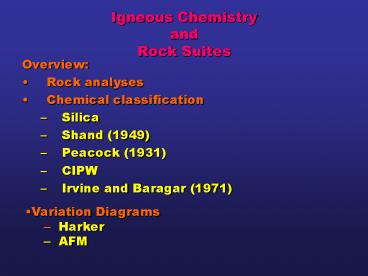Igneous Chemistry and Rock Suites - PowerPoint PPT Presentation
1 / 18
Title:
Igneous Chemistry and Rock Suites
Description:
Alumina saturation classes based on the molar proportions of Al2O3/(CaO Na2O K2O) ... b. Alumina saturation indices (Shand, 1927) with analyses of the peraluminous ... – PowerPoint PPT presentation
Number of Views:206
Avg rating:3.0/5.0
Title: Igneous Chemistry and Rock Suites
1
Igneous ChemistryandRock Suites
- Overview
- Rock analyses
- Chemical classification
- Silica
- Shand (1949)
- Peacock (1931)
- CIPW
- Irvine and Baragar (1971)
- Variation Diagrams
- Harker
- AFM
2
46.6
Abundance of the elements in the Earths crust
- Major elements usually greater than 1
- SiO2 Al2O3 FeO MgO CaO Na2O K2O H2O
- Minor elements usually 0.1 - 1
- TiO2 MnO P2O5 CO2
- Trace elements usually lt 0.1
- everything else
3
A typical rock analysis
Must multiply by of cations in oxide ?
4
(No Transcript)
5
Chemical Classifications
- Silica
- SiO2
- Silicic gt 66
- Intermediate 52-66
- Mafic 45-52
- Ultramafic lt45
6
Chemical Classifications
- Shand (1949)
- Silica saturation
- oversaturated
- saturated
- undersaturated
- Alumina saturation
- Peraluminous Al2O3 gt CaO Na2O K2O
- Metaluminous Al203 lt CaO Na2O K2O
- Al2O3 gt Na2O K2O
- Subaluminous Al2O3 Na2O K2O
- Peralkaline Al2O3 lt Na2O K2O
7
Figure 18-2. Alumina saturation classes based on
the molar proportions of Al2O3/(CaONa2OK2O)
(A/CNK) after Shand (1927). Common
non-quartzo-feldspathic minerals for each type
are included. After Clarke (1992). Granitoid
Rocks. Chapman Hall.
8
Chemical Classifications
- Peacock (1931) Classification
- Rock Series SiO2 Typical rock association
- Calcic gt61 Basalt, andesite, rhyolite
- Calcalkaline 56-61 Basalt, andesite,
rhyolite - Alkalic-calcic 51-56 Basalt, trachyte,
phonolite - Alkaline lt51 Basalt, trachyte, phonolite
9
Figure 8-10a. Plot of CaO (green) and (Na2O
K2O) (red) vs. SiO2 for the Crater Lake data.
Peacock (1931) used the value of SiO2 at which
the two curves crossed as his alkali-lime index
(dashed line). b. Alumina saturation indices
(Shand, 1927) with analyses of the peraluminous
granitic rocks from the Achala Batholith,
Argentina (Lira and Kirschbaum, 1990). In S. M.
Kay and C. W. Rapela (eds.), Plutonism from
Antarctica to Alaska. Geol. Soc. Amer. Special
Paper, 241. pp. 67-76.
10
CIPW Norm
- Norm is a calculated idealized mineralogy
- Mode is the volume of minerals seen
11
from Philpotts (1990)
12
Alkali vs. Silica diagram for Hawaiian
volcanics Seems to be two distinct groupings
alkaline and subalkaline
Figure 8-11. Total alkalis vs. silica diagram for
the alkaline and sub-alkaline rocks of Hawaii.
After MacDonald (1968). GSA Memoir 116
13
Irvine and Baragar (1971, from Philpotts, 1990)
14
(No Transcript)
15
Variation Diagrams
How do we display chemical data in a meaningful
way?
16
Bivariate (x-y) diagrams
Harker diagram for Crater Lake
Figure 8-2. Harker variation diagram for 310
analyzed volcanic rocks from Crater Lake (Mt.
Mazama), Oregon Cascades. Data compiled by Rick
Conrey (personal communication).
17
Ternary Variation Diagrams
- Example AFM diagram
- (alkalis-FeO-MgO)
Figure 8-2. AFM diagram for Crater Lake
volcanics, Oregon Cascades. Data compiled by Rick
Conrey (personal communication).
18
AFM diagram can further subdivide the
subalkaline magma series into a tholeiitic and a
calc-alkaline series
Figure 8-14. AFM diagram showing the distinction
between selected tholeiitic rocks from Iceland,
the Mid-Atlantic Ridge, the Columbia River
Basalts, and Hawaii (solid circles) plus the
calc-alkaline rocks of the Cascade volcanics
(open circles). From Irving and Baragar (1971).
After Irvine and Baragar (1971). Can. J. Earth
Sci., 8, 523-548.































